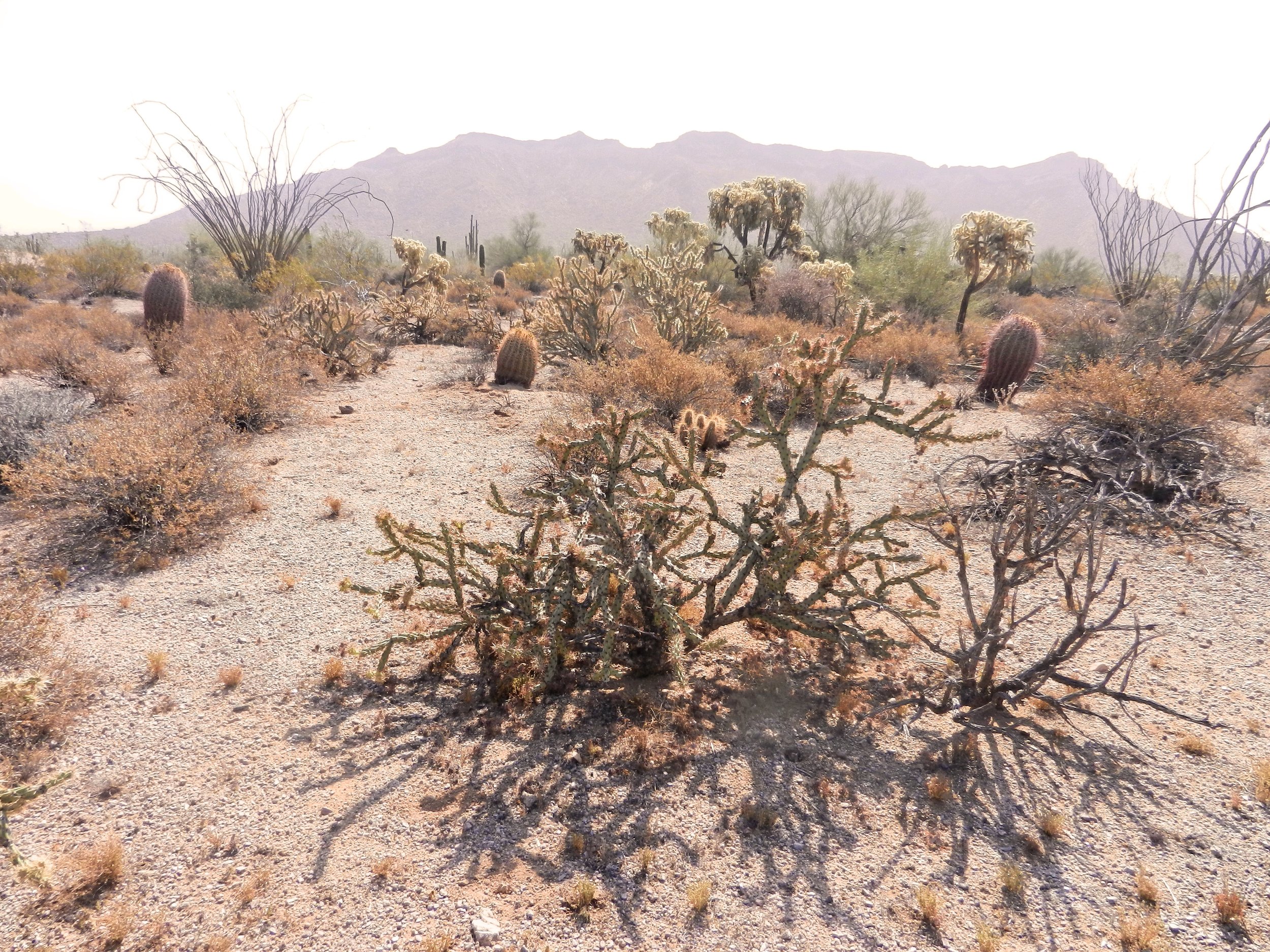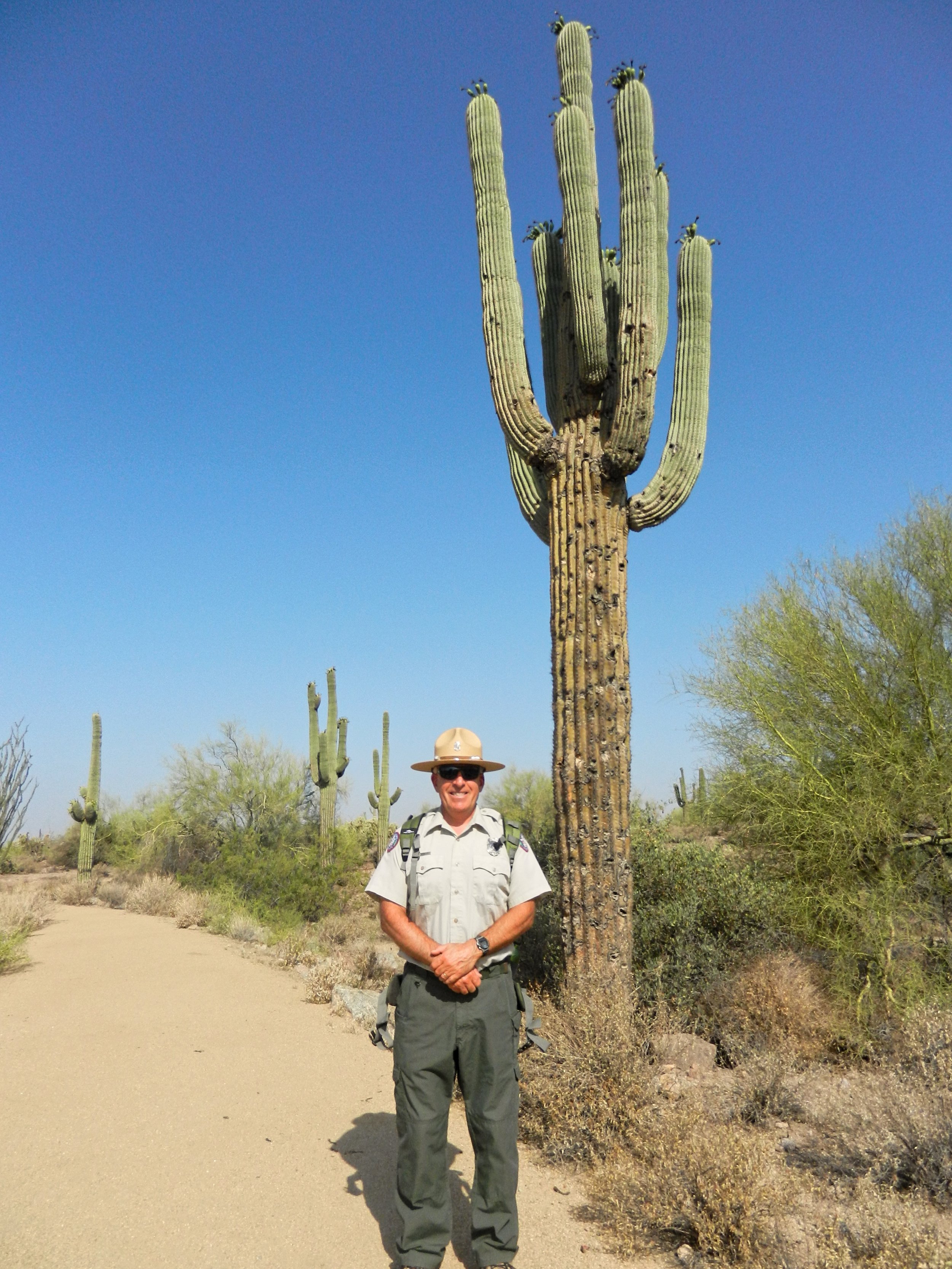The Sonoran Desert- Cacti, Edibles and Severe Heat
[This blog post is from 2012.]
Living on the west coast of Canada, nicknamed the “wet coast,” I am fascinated by the desert. So I decided to take a trip to the Sonoran Desert in Arizona in the middle of the summer to learn more about the famous saguaro cactus, the wildlife that make the desert their home, the native peoples who have lived on the land for thousands of years, and just how hot it actually gets here.
I met up with Ranger B at the Usery Mountain Regional Park Nature Centre. He runs the many programs that are available to visitors, from critters and wildlife to edibles and archaeology. I introduced him in my last post about hiking and kayaking in the Sonoran Desert.
Ranger B explains: “Usery Mountain Regional Park is 3,600 acres. We are one of 11 Maricopa County parks that ring the Metro Phoenix area within about a 45-minute drive from every direction from the downtown area. Of the over 3,000 counties in the United States, Maricopa has the largest county park system, at a total of 120,000 acres of beautiful Sonoran Desert habitat.
“We have 30 miles of hiking, biking and horseback riding trails and an estimated 2,500 different species of plants, about 60 different mammal species, about 100 different reptile species, about 400 species of birds, 25 native species of fish, and about 25 species of amphibians. That doesn’t mean they’re all here in Usery park, this is just one piece of the jigsaw puzzle.”
The Sonoran Desert in the Phoenix, Arizona area. Photo by Lori Henry.
My first question is about the iconic saguaro cactus, the gigantic ones with multiple arms that stretch into the sky.
“Saguaros are my favourite plants in the whole wide world,” enthuses Ranger B. “They’re native only to the Sonoran Desert. None of the other 19 deserts of the world have the saguaro because this desert gives them exactly what they need to live and survive here.”
Ranger B standing in front of a saguaro cactus in the Usery Mountain Regional Park. Photo by Lori Henry.
And those pesky prickly balls that attach themselves to unsuspecting hikers? “This is one of 300 different species of cacti that we have in our Sonoran Desert, known as Chain Fruit Cholla because of the dangling chains. It has a nickname, the Jumping Cactus. People think they jump – it’s one of the many myths of our desert – because all it takes is just a slight brush up against the cactus and those little joints, the fuzzy joints and balls on them, they detach from the plant and attach to you.
“They can go right through clothes and shoes, and they have microscopic little fishhook barbs in the tips of each of the spines. They will literally latch onto your skin and you’ll have to rip them out. You can take a comb under the Cholla ball and pop it straight off. It doesn’t happen if you just learn to leave everything alone in the desert – keep your hands and body parts away from all things cactus.”
I was also interested in how animals and plants survive and adapt to desert conditions. Ranger B: “Every single one of these plants and animals has a story to tell on how they survive and thrive in the desert. The saguaro cacti are actually the tallest cactuses in the United States. They utilize dozens of strategies to survive and thrive, one of them being their ability to store water, like all cacti do, and the ability to expand, and that’s why they have those pleats. Those ribs, or the ridges and valleys, give it that expandable option, like your curtains or drapes. The width increases when it rains: the roots absorb the water in the ground and the accordion-style pleats expand. They can contain up to 50% more water because of that ability to expand without splitting.”
As for animals, Ranger B talks about the Harris’ antelope squirrel as one scurries by. “They’re very common here in the desert. They’re very tough animals. They have a little bushy tail and they use it as an umbrella. You’ll see them often putting it up over their bodies like an umbrella, even when they’re running.” I’d love to have that function when it’s raining…
“If you notice all around you, you’ll see a lot of holes. The desert is covered with holes and that is because most animals in the desert live in holes. We live in a very exposed environment – we don’t have thick forest where there’s a lot of shade, so the animals go down in holes, under rocks, right down into the ground, to avoid the heat of the day.”
And then there are the really cute tortoises. Just don’t scare them because they could expel their bladder! “We have Sonoran Desert tortoises here,” says Ranger B. “They have very large bladders in which they store water and that is basically their portable water bottle. So what happens is, if a tortoise has been saving up water in its bladder, and a human comes walking towards it and says, “Oh look at this beautiful tortoise, I’km going to get my picture taken,” what happens to a tortoise with a bladder full of water? I tell people the same thing that would happen to you if your bladder was full and Godzilla walked up to you.
“That can be dangerous to the tortoise because it loses its water supply and how much rain do we get in the desert? I literally cannot remember the last time it rained here. Our record here size years ago, we went four and a half months without one drop of rain. If you’re depending on your stores water and it’s expelled, you could die. That’s one of the reasons why they’re fully protected.”
So, how hot does it actually get? “Very few people know, simply because they read temperatures and those official weather forecasts are only measured in the shade, not in the sun. The plants are in the sun, they can’t move, so how are they going to survive? Our hottest recorded day in the Phoenix area was 1`22 Fahrenheit, about 50 degrees Celsius. Now, that’s our hottest day, but it’s frequently in the summer here 45-47 degrees Celsius.
“How hot do you think it gets on our summer days at ground temperature? I’m not talking the asphalt, I’m talking the desert sediment here. 170 degrees Fahrenheit (around 70 degrees Celsius)! That’s what the plants are facing, because they have no ability to get out of the sun. When you understand the intense, harsh conditions that the plants and animals deal with, it begins to unlock how they possibly survive.
Cactus flowers in the Usery Mountain Regional Park, Arizona. Photo by Lori Henry.
“We have very high rates of evaporation, about 12:1 here in the Phoenix area. We get 12 times more evaporation than we do precipitation. If we average eight inches of rain a year, we get 12 times more evaporation, that’s 12 x 8 = 96 inches. So you’re talking eight feet of evaporation. If you have an eight-foot beach pool here and you didn’t replace water for an entire year, it would be dry at the end of the year.”
It’s hard to believe that people can survive out here, but Ranger B says there are many things that people can eat. “I don’t want to say most plants are edible, because they estimate maybe as much as 20%. But at 2,5000, 25% is 500 species, which is a lot. Every cactus species produces fruit and they’re all edible, but they’re all not equally tasty, I will say! Some are sweeter than others.
“The thing about the desert is that it’s extremely seasonal, so you’ve got this problem for native people who have lived here for thousands of yers. There is a window of opportunity for ripening desert plants and then it’s shut, but your human body has to survive another nine months of the year. They had to have ways, not only of picking them, which is a technique all unto itself, because a lot of our plants have thorns and spines. Everything either sticks, scratches or scorches here in the desert. You have to know how to pick these things, you have to know how to process them, and you have to know how to preserve them, because it has to be able to last.
“Some of the native tribes here in Arizona – there are 20 registered tribes here in the states – some of them continue to harvest the saguaro fruits in traditional ways every year, so they’ll leave their modern towns and cities and they’ll go into encampments, as basically camp out in the desert for two or three weeks, and they will go out and harvest the fruits and make from the fruits syrups, jams, molasses, ceremonial wine, even candy.
“You can buy prickly pear ice cream here on the edge of the valley, made from the juice of the prickly pear. If you ever go past Canyon Lake, its a beautiful drive out – rock formations, lakes, and it’s only a 40-minute drive from here. You come into this little old western town called Tortola Flats and they sell prickly pear ice cream in their general store.”
A cactus fruit in the Usery Mountain Regional Park, Arizona. Photo by Lori Henry.
And lastly, how was the city of Phoenix developed? “We’re a relatively new city. The 1870s is when it first started from an Anglo perspective. The whole name Phoenix, the mythical bird of the Egyptian, Roman, Mesopotamian cultures, the Phoenix is this mythical bird that basically burns itself off every 500 or 1,000 years and then rises from its own ashes. The reason that’s the symbol of Phoenix is because we’re built on an ancient civilization that pre-dated us for 2,000 years, called Hoboken people, and they had up to 1,000 miles of water canals that criss-crossed all across the valley.
“Things are still being found all the time. In fact, we could be out on the trail back here and find pieces of pottery that are 1,000 years old. I find things all the time. I found some ruins yesterday on my day off. Me and a buddy hiked way up the mountains to these canyons and found cliff dwellings. It was amazing. I find that all the time here. You can find petroglyphs, etchings in the rocks, pictographs.”
Book recommendations:* A Natural History of the Sonoran Desert, Sonoran Desert Food Plants: Edible Uses for the Desert's Wild Bounty, Sonoran Desert Plants: An Ecological Atlas and The Sonoran Desert: A Literary Field Guide.
* The above links are to Amazon and are for your reference. I receive a small referral fee if you buy from Amazon. But I encourage you to buy books from any retailer, ideally your local bookstore!



